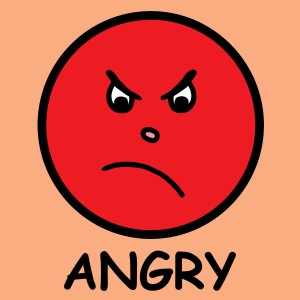 Let’s say you were an alcoholic.
Let’s say you were an alcoholic.
Would it be better to be what the people in AA programs often call a “dry drunk,” i.e., someone who isn’t drinking but is white-knuckling it the whole time, or, on the other hand, someone who actually doesn’t even think about taking a drink?
The second person, if offered, could take it or leave it. I enjoy coffee, and am sure to have a cup every morning, but if someone offered it to me in the middle of the day, I might say, “No, thanks” because it just didn’t appeal to me at that moment.
You see where I’m going? – The dry drunk wants that drink sooooo badly. The other person is not attached to his or her drink. The drink is pleasant at the right time and not of interest at other times.
That “not attachment” is the ideal place for anger.
It is useful at times and not at all of interest at other times.
Times Anger Is Useful
Anger at oneself may be useful. If you did something wrong, it is better to be really upset with yourself over it than to gloss over it as if it wasn’t important. Of course, there is another aspect of anger which is that there is an endpoint to even useful anger. Sometimes, enough is enough. We are not supposed to wallow in self-flagellation.
Anger at another could also be useful. You love your child so much, that in your eyes he could do no wrong. But he just did wrong. You may have to work yourself up just a tad to show some emotion of anger even if you’re not too committed to it, just to make an impression on him. That’s healthy.
Sometimes when someone is mistreating you and you are inclined to let it go — which is normally a good and smart thing to do — it may be better and smarter to feel the anger and not be so permissive of someone who is being mean. Sometimes letting them know in no uncertain terms is healthy so that they get the message.
In all these cases, a key is to have an endpoint to the anger. It should not go on for the whole day let alone days or weeks. I’ve had clients who, before therapy started, would keep up their bad mood for weeks. That is unhealthy for them and for everyone around them. More about that later.
It is also already under control because you basically didn’t feel so angry to begin with and you realized that you ought to be angrier so as to get your message across.
But there are people whose anger is way out of control. What about them?
Anger Management
Anger management implies that the anger is always present and when it is present, you better not let it rip; you better manage it. While that is true, that, to me, is like being a dry drunk. The dry drunk must tell himself over and over “I DON’T want that drink,” when in fact he does. He’s lying to himself.
Seething and keeping it under control is not healthy. From this, all sorts of medical problems like high blood pressure, coronary heart disease, gastro-intestinal problems, immune problems and many others arise.
Of course, just expressing anger is not healthy either. Back in the 1980’s Murray Straus at the University of New Hampshire tested this out and learned that couples who thought venting was good were less happy than those who didn’t.
So if the “dry drunk” method — holding the anger in and seething underneath — is not going to work and expressing it turns out to make things worse, what does one do with the anger?
How About Getting Rid of It
Okay, that’s a great question. And an answer has come from the East backed up by lots of clear, scientific research: The finding has been that doing some version of meditation, when you practice enough, will literally change brain structure.
So, meditation, it turns out, seems to put the little things that bother us in life into perspective. People with anger issues, anxiety, depression, and even trauma, have found their symptoms go down significantly with mindfulness meditation.
What to Do
It is not time-consuming or complicated. Just breathe. Basically, that’s it.
Well, there’s a bit more. It’s how you breathe, how long you practice for, how often you practice and what’s on your mind or, actually, not on your mind.
Here’s the low-down:
*Take deep belly breaths. I recommend downloading the free phone app, Breathe2Relax, which even has diagrams.
*Research shows that doing one minute of practice ten TIMES a day is more effective than 10 minutes at one time.
*The key — and this is extremely difficult at first but gets surprising easy after a while — is to clear your head of all thoughts. When thoughts come through, don’t argue with them or agree or anything with them; just let them go and focus, instead, on the breathing itself.
Researchers are speculating that because breathing is normally automatic but now you are consciously doing it and clearing your mind, then this process is creating neuronal pathways between the thinking part of your brain (cerebral cortex) and the automatic, highly emotional part (amygdala).
So when people say that their anger takes them by surprise and they have no control over it, they are partially right. Generally, we don’t have any control over the reactions of the amygdala. But now we can see how we can. We can, through practice, make anger a thing of the past.
Isn’t it nice to not have to “manage” it but rather not even have to deal with it — unless, of course, we want to.
I would like your comments, below, on how this works for you.
